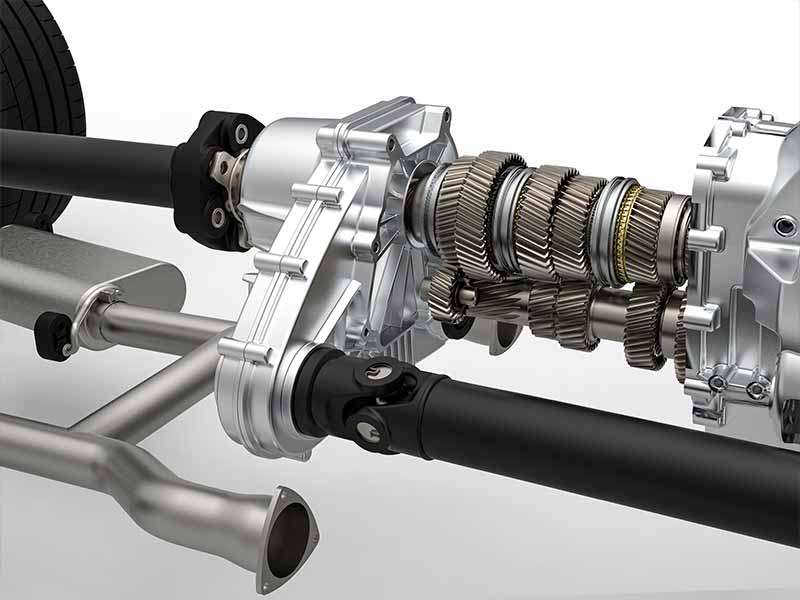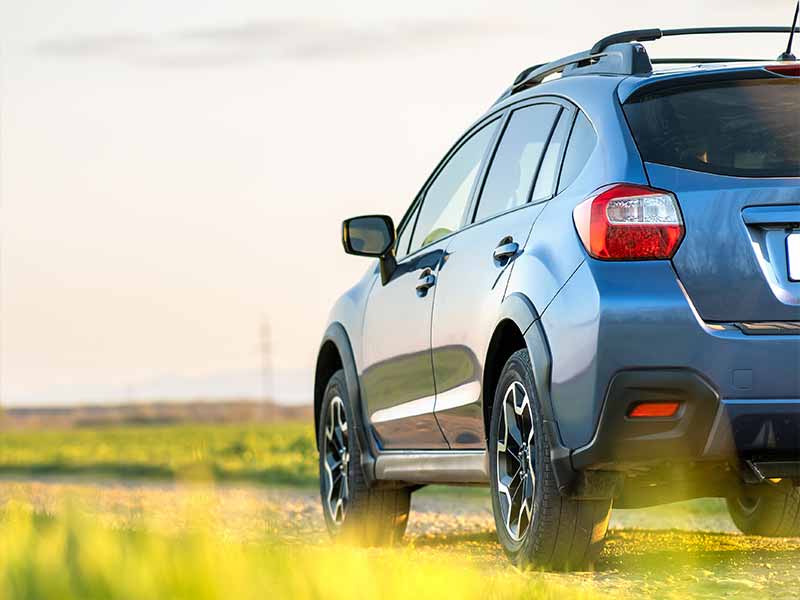Ever wonder about the inner workings of your car or truck when you push down on the gas pedal? Ever puzzled over terms like ‘drivetrain‘ and ‘powertrain’ while reading your vehicle’s manual or warranty? We’re about to steer you on a journey that demystifies these essential components of your ride!
Drivetrain Vs Powertrain
The drivetrain is a system within your vehicle that transfers power from the engine to the wheels.
The powertrain encompasses all components that generate power and deliver it to the road, including the engine, transmission, and the drivetrain.
In this article, we’ll explore the distinct functions of the drivetrain and powertrain, delve into their individual components, and understand how these systems work to move your vehicle. We’ll also dissect drivetrain and powertrain warranties, highlighting their coverage and differences, helping you be more informed when it comes to protecting your vehicle.
Let’s take a closer look.

Understanding Drivetrains
When you’re cruising down the highway, ever wondered how the power generated by your car’s engine gets to the wheels? It’s all because of a fancy thing called a drivetrain.
What is a Drivetrain?
Think of the drivetrain as the messenger in your car. It takes the power generated by the engine and delivers it to the wheels to move the car. Pretty neat, huh?
Now, you might wonder, aren’t there different types of vehicles with power going to different wheels? You’re absolutely right! And that’s where different types of drivetrains come into the picture.
Types of Drivetrains
There are primarily four types of drivetrains. These are:
- Front-Wheel Drive (FWD): In this setup, the drivetrain directs all the power to the front wheels. FWD is pretty common and is especially great for slippery conditions because the weight of the engine is over the front wheels, helping with traction.
- Rear-Wheel Drive (RWD): You guessed it, the power here goes to the rear wheels. RWD is often used in sports cars and larger trucks due to better balance and handling.
- All-Wheel Drive (AWD): An AWD drivetrain sends power to all four wheels, either all the time or when needed. This can provide improved grip and control, especially in tough driving conditions.
- Four-Wheel Drive (4WD): Similar to AWD, 4WD sends power to all four wheels. But the difference is that 4WD is designed more for severe off-road conditions.
Drivetrain Components
Let’s dive into the nitty-gritty of what makes up a drivetrain. This system is more than just a messenger; it’s composed of several parts working together in harmony. The main components of a drivetrain are:
- Transmission: This is the gear wizard. The transmission takes the power from the engine and converts it into torque, or rotational force, via various gear ratios.
- Driveshaft: Consider this the middleman. The driveshaft is a long metal rod that runs down the length of the vehicle. It takes the torque from the transmission and passes it along to the next component, the differential.
- Differential: The differential is like a traffic cop, directing the torque from the driveshaft to the wheels. And it doesn’t just split power evenly; it allows the wheels to rotate at different speeds, particularly useful when you’re turning corners.
- Axles: The axles are the final piece of the puzzle, transmitting the torque from the differential to the wheels.

Exploring Powertrains
Now that we’ve got a grip on drivetrains, let’s shift gears and steer towards another essential system in your vehicle – the powertrain.
What is a Powertrain?
Imagine you’re the coach of a sports team. You’ve got your star players who do most of the heavy lifting and some role players who support the team to win the game. In the vehicle world, the powertrain is like the whole team. It includes the star players, the engine, and the transmission (also part of the drivetrain), and even the driveshaft and axles.
So, in simple terms, the powertrain is the group of components that generate power (like your engine) and deliver it to the road surface (like the drivetrain).
Powertrain Components
Let’s do a roll call of the powertrain team:
- Engine: The star player, the engine, is where it all begins. It generates power by burning fuel (either gasoline, diesel, or in some cases, electricity) and creates a force that’s sent to the transmission.
- Transmission: Remember the gear wizard from our drivetrain section? Here it is again, in the powertrain line-up! Just as before, the transmission’s job is to convert and transmit the power from the engine to the drivetrain.
- Drivetrain: This is our group of role players, including the driveshaft, differential, and axles. As we learned earlier, they take power from the transmission and send it to the wheels.

Drivetrain Vs Powertrain: The Differences
In the realm of vehicles, terms like drivetrain and powertrain often get tossed around like a hot potato. We’ve already dug deep into what these two are and their various components. Now, let’s look at how they stack up against each other. Buckle up, folks, it’s comparison time!
Drivetrain and Powertrain: More Alike Than You’d Think
Before we start comparing, it’s crucial to realize that drivetrains and powertrains aren’t competing against each other. Rather, they work together like peanut butter and jelly to get your car moving.
Remember, the drivetrain is like a messenger, taking the power from the engine and delivering it to the wheels. The powertrain, on the other hand, is more like the entire mail delivery system. It includes the power creation (engine), power management (transmission), and power delivery (drivetrain).
The Key Differences
So, if they’re part of the same team, what makes them different? Well, it all boils down to their roles:
- The Role of the Engine: This is where the divergence begins. The drivetrain doesn’t include the engine, while the powertrain does. Think of it this way, the powertrain starts at the engine and ends at the wheels, while the drivetrain starts at the clutch and ends at the wheels.
- Transmission Duties: The transmission is part of both systems, but it has a bit of a different role in each. In the drivetrain, the transmission helps manage the torque or power that’s sent to the wheels. In the powertrain, it helps control the power from the engine and sends it to the drivetrain.
- Who’s Delivering the Power: Finally, the drivetrain is all about power delivery – taking power from the transmission and getting it to the wheels. The powertrain, on the other hand, covers the whole process from power creation to power delivery.

Warranties: Drivetrain Vs Powertrain
When buying a vehicle, warranties are like the superhero sidekick you didn’t know you needed. They’ve got your back when things go south. But, with different types of warranties like drivetrain and powertrain, things can get a bit, well, confusing. So let’s break them down!
Drivetrain Warranty: Your Drive System’s Safety Net
Drivetrain warranties cover all the parts that make up your drivetrain – remember the transmission, driveshaft, axles, and differential? These components, although built to last, can wear out or malfunction. If that happens during the warranty period, the costs to repair or replace these parts are covered.
Here’s what a typical drivetrain warranty covers:
- Transmission: The gear wizard is a complex piece with lots of moving parts. Any issues related to it, like gear shifting problems, are usually covered.
- Driveshaft, Differential, and Axles: These important role players are also covered. If they start acting up, causing problems like strange noises or vibrations, the warranty has got you covered.
But remember, warranties don’t cover everything. Wear and tear items like clutches or damage caused by poor maintenance usually aren’t covered. Always read your warranty’s fine print!
Powertrain Warranty: The Whole Package Deal
On the other hand, powertrain warranties are more extensive. They cover everything that the drivetrain warranty does, plus the engine. This coverage makes a powertrain warranty a more comprehensive (and typically longer) coverage. It’s like getting an umbrella that not only keeps your head dry but also your backpack.
Here’s what a typical powertrain warranty covers:
- Engine: As the heart of your car, engine problems can be serious (and costly!). From oil leaks to complete engine failure, a powertrain warranty usually covers it.
- Transmission and Drivetrain: Just like the drivetrain warranty, your transmission, driveshaft, differential, and axles are covered here as well.
Again, it’s important to remember that warranties have their limitations. Normal wear and tear, improper maintenance, and damage due to accidents usually aren’t covered.
Drivetrain Vs Powertrain Warranty: The Showdown
So, which is better? It depends on what you’re looking for. A drivetrain warranty covers less but might be sufficient if your primary concern is the parts that deliver power to the wheels. On the flip side, a powertrain warranty offers more extensive coverage, including the engine, giving you more peace of mind.
Resources
Below are some links you may find helpful when learning about tires
- What is the difference between powertrain and drivetrain? – Motor Biscuit
- Drivetrain warranty – Motor1.com
Final Thoughts
In the realm of vehicles, drivetrains and powertrains play crucial roles. The drivetrain, with components like the transmission, driveshaft, differential, and axles, functions as a messenger, delivering power from the engine to the wheels. On the other hand, the powertrain, encompassing the engine, transmission, and drivetrain, is the whole postal service of your vehicle, overseeing power creation, management, and delivery.
When it comes to warranties, a drivetrain warranty acts as a safety net for your drive system, while the powertrain warranty offers a more comprehensive deal, including the engine. Understanding the specifics of your vehicle’s warranty can save you time and money in the long run.
Good luck and happy motoring.





